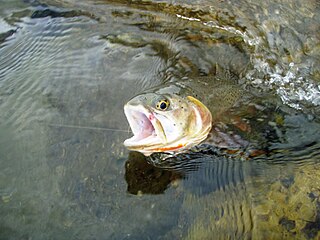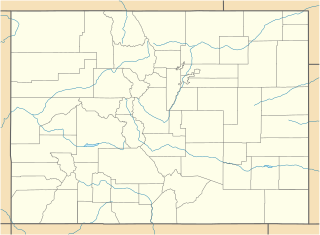The National Fish Hatchery System (NFHS) was established by the U.S. Congress in 1871 through the creation of a U.S. Commissioner for Fish and Fisheries. This system of fish hatcheries is now administered by the Fisheries Program of the U.S. Fish and Wildlife Service (Service), an agency within the United States Department of the Interior.

The rainbow trout is a trout and species of salmonid native to cold-water tributaries of the Pacific Ocean in Asia and North America. The steelhead is an anadromous (sea-run) form of the coastal rainbow trout(O. m. irideus) or Columbia River redband trout (O. m. gairdneri) that usually returns to fresh water to spawn after living two to three years in the ocean. Freshwater forms that have been introduced into the Great Lakes and migrate into tributaries to spawn are also called steelhead.

The cutthroat trout(Oncorhynchus clarkii) is a fish species of the family Salmonidae native to cold-water tributaries of the Pacific Ocean, Rocky Mountains, and Great Basin in North America. As a member of the genus Oncorhynchus, it is one of the Pacific trout, a group that includes the widely distributed rainbow trout. Cutthroat trout are popular gamefish, especially among anglers who enjoy fly fishing. The common name "cutthroat" refers to the distinctive red coloration on the underside of the lower jaw. The specific name clarkii was given to honor explorer William Clark, coleader of the Lewis and Clark Expedition.

Myxobolus cerebralis is a myxosporean parasite of salmonids that causes whirling disease in farmed salmon and trout and also in wild fish populations. It was first described in rainbow trout in Germany a century ago, but its range has spread and it has appeared in most of Europe, the United States, South Africa, Canada and other countries. In the 1980s, M. cerebralis was found to require a tubificid oligochaete to complete its life cycle. The parasite infects its hosts with its cells after piercing them with polar filaments ejected from nematocyst-like capsules.

Oncorhynchus is a genus of fish in the family Salmonidae; it contains the Pacific salmon and Pacific trout. The name of the genus is derived from the Greek ὄγκος + ῥύγχος, in reference to the hooked jaws of males in the mating season.

Fish stocking is the practice of raising fish in a hatchery and releasing them into a river, lake, or ocean to supplement existing populations or to create a population where none exists. Stocking may be done for the benefit of commercial, recreational, or tribal fishing, but may also be done to restore or increase a population of threatened or endangered fish in a body of water closed to fishing.

The Lake Fish Hatchery Historic District comprises nine buildings built between 1930 and 1932 by the U.S. Fish and Wildlife Service in the National Park Service Rustic style. The buildings exhibit a consistency of style and construction, with exposed gable trusses and oversized paired logs at the corners, all with brown paint. The district is located on the shore of Yellowstone lake near the Lake Hotel The hatchery was established to provide Yellowstone cutthroat trout eggs for state and federal hatcheries outside Yellowstone.

A cutbow is an interspecific fertile hybrid between a rainbow trout and a cutthroat trout. Cutbow hybrids may occur naturally where the native ranges of both species overlap, such as between coastal rainbow trout and coastal cutthroat trout and between Columbia River redband trout and westslope cutthroat trout. While natural separation of spawning habitat limited hybridization in most native populations of rainbows and cutthroats, introduction of non-native hatchery-raised rainbow trout into the native ranges of cutthroat subspecies increased the rate of hybridization. Some native cutthroat populations are, as a result, at risk due to genetic pollution.

The Bozeman National Fish Hatchery, now known as Bozeman Fish Technology Center, is located about 4 miles (6.4 km) northeast of Bozeman, Montana, at the entrance to Bridger Canyon. There is also a National Fish Health Center on the southwest side of Bozeman, near Montana State University, about 7 miles (11 km) away from the Fish Technology Center. Fish Technology Centers work with a wide variety of public and private partners to improve and conserve aquatic resources. Both the Fish Technology Center and the Fish Health Center are part of the National Fish Hatchery System, operated by the United States Fish and Wildlife Service. There are seven Fish Technology Centers and nine Fish Health Centers in the United States. The Bozeman hatchery is the fourth oldest National Fish Hatchery. The hatchery was named to the National Register of Historic Places on January 6, 1983.

The Chalk Cliffs Rearing Unit is a Colorado Parks and Wildlife cold water fish production facility located near Arkansas River and Chalk Creek in Chaffee County, Colorado. Hatchery staff works to support the raising of approximately 700,000 catchable, ten-inch rainbow trout annually. The hatchery stocks fish along the Front Range from Loveland to the New Mexico border, and east almost to the Kansas border.

The Crystal River Hatchery is a Colorado Parks and Wildlife cold-water fish production facility located along the Crystal River in Garfield County, Colorado, near Carbondale. The hatchery raises rainbow trout and Snake River cutthroat trout brood fish. The millions of eggs from these brood fish are shipped to other hatcheries to be raised for stocking.

The Durango Fish Hatchery is a Colorado Parks and Wildlife cold water fish production facility located near the Animas River in Durango, Colorado. The hatchery staff raise rainbow, brown, Snake River and native cutthroat trout, and kokanee salmon.

The Finger Rock Rearing Unit is a Colorado Parks and Wildlife cold water fish production facility located near Bear River in Routt County at the base of Flat Tops Wilderness Area.

The Glenwood Springs Hatchery is a Colorado Parks and Wildlife cold water fish production facility located on Mitchell Creek near the Colorado River in Garfield County, which is 2 miles north of West Glenwood Springs.

The Mt. Shavano Hatchery is a Colorado Parks and Wildlife cold water fish production facility located near Arkansas River headwaters at the base of Big Baldy Mountain in Chaffee County. This facility is considered one of the largest trout units in the state.

The Pitkin Hatchery is a Colorado Parks and Wildlife cold water fish production facility located in Gunnison National Forest right off of Quartz Creek Valley in Gunnison County.

The Poudre Rearing Unit is a Colorado Parks and Wildlife cold water fish production facility located near Cache la Poudre River at the base of South Bald Mountain in Larimer County. It is considered one of the smaller units in Colorado.

The Rifle Falls Fish Hatchery is a Colorado Parks and Wildlife cold water fish production facility located off East Rifle Creek near Rifle Falls State Park in Garfield County.

The Roaring Judy Hatchery is a Colorado Parks and Wildlife cold water fish production facility located on East River at the base of Flat Top mountain in Gunnison County. It home to the largest known kokanee salmon run in Colorado.










